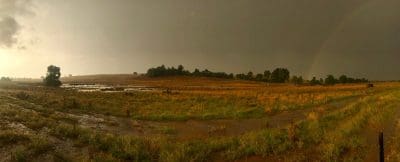
Pockets of the Harden and Young district had up up to 100 millimetres of storm rain yesterday. This farm at Harden received 80mm in less than one hour. Photo: Peter Holding
FALLS of up to 100 millimetres in pockets of southern New South Wales in the past day are expected to regenerate heat-affected lucerne crops, and build subsoil moisture reserves for growers getting ready to plant early winter forage crops.
Rainfall in the 24 hours to 9am today included up to 28 millimetres at Condobolin, 80mm at Young, 25mm at Forbes, and 15mm at Urana.
In recent days, the southern slopes and tablelands have also had some handy falls totalling 26mm at Albury, 67mm at Bombala and 65mm at Taralga.
Early oats and grazing canola are expected to head the list of forage crops sown on the tablelands and inner slopes later this month.
Growers on the outer slopes and plains are likely to wait until next month to plant to avoid the risk of late-summer heat stressing or killing early planted crops.
IMAG Forbes-based agronomist Cameron Corke said dryland lucerne would be the big beneficiary of the recent rain which fell in parts of the Lachlan Valley.
“Out here on the plains, it’s too early to plant oats or other forage crops, because daytime temperatures can get high in February, and you’d want to be sure you were going to get follow-up rain if you planted now,” Mr Corke said.
“There are also some summer crops around — a bit of sorghum, some millet, and cowpeas — and they may respond well to the rain too.”
Falls in the wider Forbes-Condobolin district totaled 10-20mm in most places, and up to 50mm.
Mr Corke believes the district’s large-scale farmers will wait until April to open their cash-cropping programs with winter wheat.
“Since Boxing Day, we’ve had heatwaves week after week, and people are looking to get a fair bit more rain in the profile – at least 50mm – before they’ll plant.
“They’re hoping for an early to normal start, because there is some subsoil moisture under some of those failed crops from last year.”
Mr Corke said an early break could see canola being planted, and lupins on lighter country, with cereals likely to dominate in the main planting window, and chickpeas likely to make an appearance on heavier country in later plantings.
“Barley on the early plant in May tends to do quite well, so we could see some of that.”
Delta Agribusiness Young-based agronomist Dave Crowley said rain in the district was “extremely patchy”, with 10-100mm reported, and 10mm forecast to fall on Friday.
“A bit of early oats and grazing canola could go in on this, but it’s been so hot, and most people will wait until the middle of March to sow grazing varieties, and until the end of April for their main-season crops,” Mr Crowley said.
Baker Seed Company’s sales and business development manager Aaron Giason at Rutherglen in north-east Victoria said concerns about a return to hot weather would prevent most farmers from sowing dual-purpose crops this early, but it would be useful to the winter-cropping program.
“Any rain will help to build up soil moisture, freshen up perennial lucerne, and freshen up weeds so farmers get a good kill before winter cropping.
“Early wheats and oats are there in the mix when the opportunity is there with more rain, and the timing is right.
“We got 30mm the other day, and it’s not enough to get us going.
“At the end of this month, and with enough soil moisture, people will be going for oats on the tablelands, and in March to open winter-cropping programs on the slopes.”
Grain Central: Get our free daily cropping news straight to your inbox – Click here

HAVE YOUR SAY